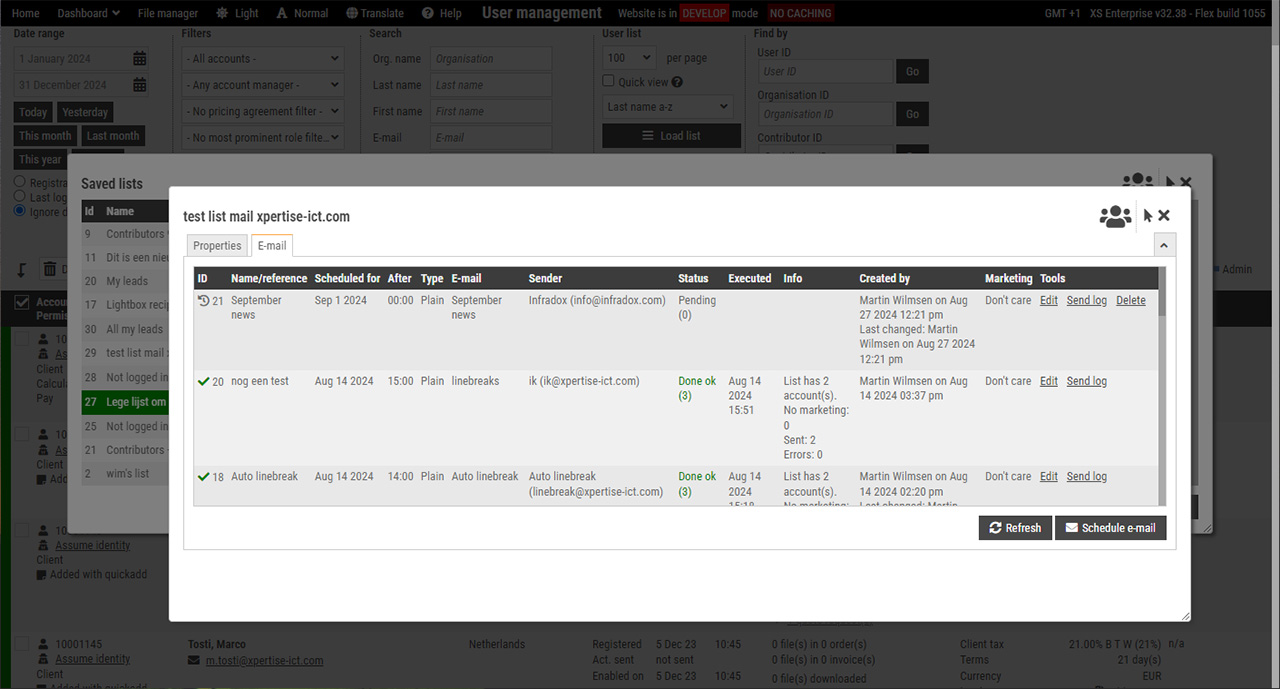Staff members can create orders into a user’s account without having to sign in as that user. It is also possible to add files to an order or cart for any user from the preview pages. This is described in the article Preview page user actions. Furthermore you can copy files from any user’s cart to any of your lightboxes or to your cart. For more information, read the article Working with client lightboxes and carts.
How it works
Prepare this action by adding the files for which you will be creating an order to one of your lightboxes first. In the administrator’s menu, go to User management and find the user account. The column Files has a link x file(s) in the cart – where x is the number of files currently in the user’s cart. Click on that link to open the action panel underneath the user details row in the list.
Creating an order
Click the link Create order into account. A dialog will appear. At the top of the dialog, select the lightbox that has the files that you have prepared for this action.
- Enable download permissions
If you want to allow the user to immediately download the files, then check this box. Note that this option is not relevant if the user already has immediate download permissions on his/her account. In that case the user will be able to download the files regardless – unless you change the permissions on the order after creating it (more on that below). - File sizes for RF files
If the order has RM files, then the user will be able to select from the available download sizes. If the order has RF files then the file size must be selected beforehand. In this dialog you can either choose to make the largest or smallest files available for download. - Notifying the user
If you want to send the user an e-mail notification about this order, then check the box Send an e-mail notification and enter a subject and message. The user’s e-mail address will be already there. If you want to be able to review or change the order before notifying the user, then uncheck the notification box. - Reviewing and/or changing the order
If you need to make changes to the order (e.g. to add prices, to change permissions on the order et cetera), then click the checkbox Open order in administrator’s view at the bottom of the dialog. If this option is selected, then the administrator’s order page will load after you submit the dialog.
Note that you will of course be able to change the order regardless of this setting by finding it in the Order management overview.
Adding files to an order created by a user
It is also possible to add files to an order that was created by a user. Go to Order management and open the order that you want to change. If you have changes to the order, then save the order before you start to add files, because the order will reload after you add files. In the toolbar at the top of the page, click Add file. A file look up dialog will appear. You can enter a file number or any keyword to list files. Then, click on the file that you want to add.
Adding files to the user’s cart
Alternatively, you can add files to the user’s cart after which the user will be able to complete the order process themselves. This will allow the user to remove files he/she doesn’t want first. You can add the contents of one of your lightboxes with the link Copy lightbox into cart or you can add single files one-by-one with the Add file to cart link.
Using the website as a client
If you need to help a client and for this you need to be logged in as that user, then this is possible by use of the Assume identity function. Find the user account in User management and click on the Assume identity link in the overview. Note that if this link doesn’t show, then it is not possible to log in as this specific user. Accounts must be enabled and activated – and accounts with certain permissions can not be used with this function either. If you click Assume identity, then you’ll be logged out and logged in as that user. If the user is logged in as well, then the user will now be logged out.



